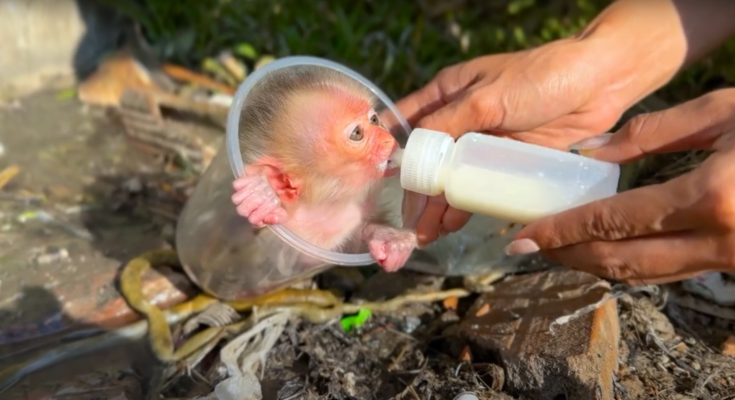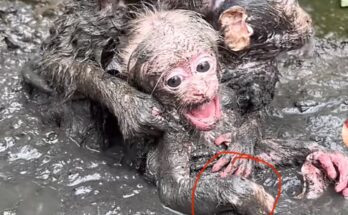Little baby monkeys, like all young animals, are incredibly vulnerable and need protection, especially when they find themselves in hazardous situations. Muddy water can be a particularly dangerous environment for these fragile creatures, as it poses a risk of drowning, injury, or infection. If you come across a baby monkey trapped or struggling in muddy water, it’s crucial to act swiftly and carefully to ensure its safety. Here’s a guide on how to save a little baby monkey from muddy water while minimizing harm and stress to the animal.
1. Stay Calm and Assess the Situation
The first step in any rescue mission is to stay calm. Panic can not only make the situation more stressful but can also hinder your ability to think clearly. When you see a baby monkey in muddy water, take a few moments to observe the surroundings. Check if the monkey is alone or if there are other adult monkeys around, as this could help you determine how best to approach the situation.
If there are adult monkeys nearby, they may be protective of their young and might become aggressive if they perceive you as a threat. If this is the case, it might be safer to call animal control or local wildlife rescue professionals to handle the situation.
2. Approach the Baby Monkey Slowly and Gently
Approach the baby monkey cautiously, making sure to minimize loud noises or sudden movements that could cause it distress. Sudden movements might startle the baby monkey or make it panic, which could make the situation worse.
As you approach, remember that baby monkeys are naturally frightened and might attempt to escape or cling to whatever they can find for support. Offer a calm, gentle voice to reassure it that you’re there to help.
3. Safely Remove the Baby Monkey from the Muddy Water
When you are close enough to the baby monkey, it’s time to gently remove it from the water. Carefully scoop the monkey out of the mud using both hands to support its body and avoid any rough handling. If the monkey is struggling or appears to be in shock, be even more gentle in your approach. If the mud is thick and difficult to move through, try to guide the monkey out slowly, allowing it to grip onto your arms or clothes if possible.
Be cautious of sharp objects in the mud, like rocks or sticks, that could cause injury to the monkey during the rescue.
4. Provide Warmth and Comfort
Once you have safely removed the baby monkey from the muddy water, it’s crucial to provide immediate warmth and comfort. Baby monkeys can become chilled very quickly, especially after being in cold or muddy water. Wrap the baby monkey in a clean, soft cloth or towel to help regulate its body temperature.
Avoid holding the baby monkey too tightly or in a way that could cause stress. Instead, create a safe space where it can rest and regain its composure. In some cases, it may be necessary to keep the baby warm using an emergency heat source, such as a warm water bottle wrapped in a towel.
5. Assess the Monkey for Injuries or Illness
After the rescue, carefully examine the baby monkey for any signs of injuries, such as cuts, bruises, or scrapes, which could have occurred while it was struggling in the mud. If the monkey seems disoriented, lethargic, or has trouble moving, it could be suffering from shock or internal injuries. These are signs that immediate veterinary attention is required.
If you notice any serious injuries or the baby monkey does not improve in the hours following your rescue, contacting a wildlife expert or veterinarian is essential to ensure the monkey receives the proper medical care.
6. Release the Baby Monkey or Seek Professional Help
If you are confident that the baby monkey is in good health and its family is nearby, you may consider releasing it back into the wild. However, in many cases, particularly if the baby is orphaned or severely injured, the best course of action is to contact a local wildlife rescue center. They have the expertise and resources to provide rehabilitation and, if necessary, reintroduction to the wild once the monkey has fully recovered.
Conclusion
Saving a baby monkey from muddy water requires a combination of patience, knowledge, and compassion. By acting swiftly and gently, you can ensure the safety of the little monkey while minimizing stress and injury. Whether you’re a wildlife enthusiast or simply a kind-hearted individual, your actions can make a life-saving difference for these vulnerable creatures. Always remember, when in doubt, call for professional help to ensure the well-being of the animal and its future.



